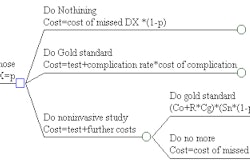SALT LAKE CITY – The gastrointestinal access services specialty is still open for the taking by interventional radiologists, according to a talk Friday at the Society for Interventional Radiology (SIR) conference. Currently, radiologists provide just 7% of all gastrointestinal access services in the U.S.
While gastroenterologists, interventional radiologists, and other physicians all have a hand in the GI market share, "what we don’t know is the frequency with which interventional radiologists provide enteral access services," said Dr. Richard Duszak, Jr., from the Reading Hospital and Medical Center in Reading, PA. Co-author Michael Mabry is the assistant executive director for policy with the Fairfax, VA-based SIR.
Duszak and colleagues' goal was to evaluate national trends in enteral access services with respect to provider specialty. The authors reviewed four years of Medicare data (1997-2000) for trends in gastrointestinal access procedures. The CPT codes for the following enteral access services were selected:
- Gastrostomy tube placement -- 43246, 43653, 43750, 43830, 43831, 43832.
- Feeding-tube maintenance services – 43760, 43761.
For all sampled enteral access procedures, the total annual number of services to Medicare beneficiaries increased by 1.4%, from 279,509 to 283,353, Duszak reported.
Gastroenterologists provided the majority (48.6%) of these services, followed by surgeons (25.1%), and others/non-radiologists (18.9%). Radiologists provided 7.3% of these services.
Over the four-year period, total procedural volumes increased for radiologists by 29.6% (15,989 to 20,022). For gastroenterologists, the change was +6.9%. Both surgeons (-4.9%) and non-radiologists (-10.2%) experienced drops in volume.
Radiologists saw the biggest leap (46.9%) in volume for new gastrostomy access. For feeding-tube maintenance, interventional radiologists also saw a volume increase of 21.8% (from 11,049 to 13,463). However, radiologists were not the only ones to see an upswing: Emergency physicians and physician extenders posted a 7.9% increase in the volume of feeding-tube maintenance procedures. Other specialists saw a downturn.
"This increase (for radiologists) is largely at the expense of surgeons and non-gastroenterologists," Duszak said. "The potential for enteral access service growth by radiologists is very high."
Duszak acknowledged some limitations of the study: data could not be analyzed for either errors or improvements in coding methods, he said. Also, referral patterns were not looked at.
In comments made immediately following Duszak’s talk, Dr. Michael Brunner, the president-elect of SIR, praised the study and the news that radiologists are gaining ground on surgeons. Brunner also addressed the issue of referrals, saying that many of these GI cases are passed on to interventional radiologists from other doctors.
"(But) we’re not getting a huge number of referrals from gastroenterologists," said Brunner, who is based at the Swedish Covenant Hospital in Chicago. "What we really need to do is ask ourselves ‘What do we do better than gastroenterologists?'"
Gastroenterologists continue to dominate this field because of the large volume of diagnostic gasteroscopies they perform. In addition, gastroenterologists tend to have better name recognition among other healthcare practitioners (e.g. the nursing home requesting tube maintenance follow-up), Brunner said.
What interventional radiologists need to do is promote the true value of the skills in the healthcare community, he said. For example, radiologists can offer better and more reliable enteral access using guidewires than gastroenterologists can with a scope.
Duszak said one reason why interventional radiologists may have given up some market share to gastroenterologists is that radiologists are concentrating their efforts on more complex procedures such as embolization.
By Shalmali PalAuntMinnie.com staff writer
March 28, 2003
Copyright © 2003 AuntMinnie.com



















